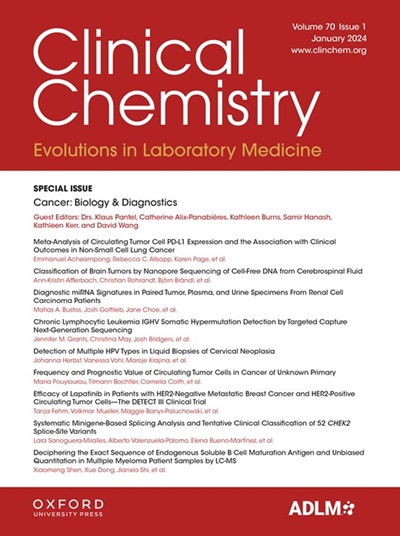Cardiac Troponin I and T Ratio and Risk of Cardiovascular or Non-Cardiovascular Events in a General Population
IF 7.1
2区 医学
Q1 MEDICAL LABORATORY TECHNOLOGY
引用次数: 0
Abstract
Background Emerging evidence suggests that the ratio between cardiac troponin (cTn) I and T may provide information on the risk of adverse outcomes in individuals with cardiovascular disease. Whether the cTn I/T ratio provides prognostic insights in the general population is unknown. Methods The cTn I/T ratio was calculated in 8855 participants (43% female, median age 56 years) from the Generation Scotland Study where both cTnI and cTnT concentrations were above the limit of blank. Multivariable cause-specific Cox proportional hazard models were used to estimate the associations between cTn I/T ratio and the primary outcome of cardiovascular or non-cardiovascular death. Results The median cTn I/T ratio was 0.5 (25th–75th percentile, 0.3–0.8) and median follow-up was 11.4 (10.8–12.7) years. Individuals in the highest ratio tertile (≥0.64) were more likely to be male, have a higher body mass index and systolic blood pressure, and a history of cardiovascular disease. Those in the lowest ratio tertile (<0.38) were more likely to be smokers or have diabetes. After adjustment for cardiovascular risk factors, the cTn I/T ratio was positively associated with cardiovascular death (per doubling increase, adjusted hazard ratio [HR] 1.16 [95% CI, 1.05–1.28]), while an inverse association was observed for non-cardiovascular death (HR 0.89 [95% CI, 0.81–0.99]). Conclusions The cTn I/T ratio is positively associated with cardiovascular death in the general population, while inversely associated with non-cardiovascular death. Future research is needed to unravel underlying mechanisms and determine whether the cTn I/T ratio provides valuable information regarding risk of cardiovascular and non-cardiovascular mortality to guide further management.普通人群心肌肌钙蛋白I和T比值与心血管或非心血管事件的风险
新出现的证据表明,心肌肌钙蛋白(cTn) I和T之间的比值可能提供心血管疾病患者不良结局风险的信息。cTn I/T比值是否在一般人群中提供预后信息尚不清楚。方法计算来自苏格兰一代研究的8855名参与者(43%为女性,中位年龄56岁)的cTnI /T比率,其中cTnI和cTnT浓度均高于空白限制。使用多变量病因特异性Cox比例风险模型来估计cTn I/T比率与心血管或非心血管死亡主要结局之间的关系。结果中位cTn I/T比值为0.5(25 - 75百分位,0.3-0.8),中位随访时间为11.4(10.8-12.7)年。比例最高的个体(≥0.64)更可能是男性,具有较高的体重指数和收缩压,并且有心血管疾病史。比率最低(0.38)的人更有可能是吸烟者或糖尿病患者。校正心血管危险因素后,cTn I/T比值与心血管死亡呈正相关(每增加一倍,校正危险比[HR] 1.16 [95% CI, 1.05-1.28]),而与非心血管死亡呈负相关(HR 0.89 [95% CI, 0.81-0.99])。结论cTn I/T比值与普通人群心血管死亡呈正相关,与非心血管死亡呈负相关。未来的研究需要揭示潜在的机制,并确定cTn I/T比值是否提供有关心血管和非心血管死亡风险的有价值信息,以指导进一步的管理。
本文章由计算机程序翻译,如有差异,请以英文原文为准。
求助全文
约1分钟内获得全文
求助全文
来源期刊

Clinical chemistry
医学-医学实验技术
CiteScore
11.30
自引率
4.30%
发文量
212
审稿时长
1.7 months
期刊介绍:
Clinical Chemistry is a peer-reviewed scientific journal that is the premier publication for the science and practice of clinical laboratory medicine. It was established in 1955 and is associated with the Association for Diagnostics & Laboratory Medicine (ADLM).
The journal focuses on laboratory diagnosis and management of patients, and has expanded to include other clinical laboratory disciplines such as genomics, hematology, microbiology, and toxicology. It also publishes articles relevant to clinical specialties including cardiology, endocrinology, gastroenterology, genetics, immunology, infectious diseases, maternal-fetal medicine, neurology, nutrition, oncology, and pediatrics.
In addition to original research, editorials, and reviews, Clinical Chemistry features recurring sections such as clinical case studies, perspectives, podcasts, and Q&A articles. It has the highest impact factor among journals of clinical chemistry, laboratory medicine, pathology, analytical chemistry, transfusion medicine, and clinical microbiology.
The journal is indexed in databases such as MEDLINE and Web of Science.
 求助内容:
求助内容: 应助结果提醒方式:
应助结果提醒方式:


